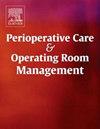Effect of different doses of ephedrine on the incidence of second episode of hypo-tension during elective cesarean section under subarachnoid block: Time to event analysis; randomized clinical trial
IF 1
Q2 Nursing
Perioperative Care and Operating Room Management
Pub Date : 2025-01-31
DOI:10.1016/j.pcorm.2025.100479
引用次数: 0
Abstract
Background
Hypotension is the most prevalent consequence of spinal anesthesia (SA). Ephedrine is a commonly employed medication that successfully elevates arterial blood pressure while maintaining uteroplacental perfusion, primarily through its cardio-acceleratory effects. The objective of the study was to estimate the incidence of and time to second hypotension by using three different doses.
Methods
This randomized double-blinded study was multicentric and carried out on 300 parturients planning to have elective CS under SA. Parturients were randomly divided equally into three groups to receive either a 5 mg (group I),10 mg (group II), or 15 mg (group III) ephedrine IV after the first hypotension. The study time was from spinal anesthesia to delivery, and blood pressure measurements were noninvasive at three-minute intervals. The starting point was the first hypotension and the endpoint of interest was a second episode of hypotension.
Results
The incidence of a second episode of hypotension was significantly lower in group II [29 (30.21%)] and III [11(11.34%)] than in group I [41(44.09%)] P<0.05 and lower in group III than II (P<0.001). The time taken until the second episode of hypotension by minutes was significantly delayed in group II (20.6 ± 2.63) and III (26.5± 4.61) than in group I (16.4 ± 2.23), (P<0.001) and in group III than group II, (P<0.001). Meantime free from hypotension by minutes with 95% CI in group I [24 (22.59 to 25.40)] was less than group II and III, while in group II was 27.16(26.24 to 28.06), less than group III 29.59(29.21 to 29.98) P<0.001. Hazard ratio with 95%CI when group III as a reference group, the risk of occurrence of hypotension in group I was 5.17 (2.99 to 8.94) times compared to group III, while in group II was 2.88 (1.72 to 4.80) times in compared to group III.
Conclusions
In SA, the higher the dose of ephedrine used significantly the lower the incidence of 2nd hypotension with non-significant adverse effects on the fetus, blood loss, and hemodynamic effect. Moreover, the dose of 15 mg ephedrine is the most effective one compared with the smaller dosages (5 or 10 mg).
Trial registration
This study was registered at Aswan University IRP 669/10/2022 and Clinical Trials.gov (registration number: NCT05993182). The registration date for this experiment is 15/08/2023. Enrollment was from August 20, 2023, to January 1, 2024.
不同剂量麻黄碱对蛛网膜下腔阻滞择期剖宫产术第二次低血压发生率的影响:时间到事件的分析随机临床试验
背景:低血压是脊髓麻醉(SA)最常见的后果。麻黄碱是一种常用的药物,主要通过其心脏加速作用,成功地提高动脉血压,同时维持子宫胎盘灌注。本研究的目的是通过使用三种不同的剂量来估计第二次低血压的发生率和时间。方法采用随机双盲、多中心研究方法,对300例计划择期行骶管造影的产妇进行研究。产妇被随机分为三组,分别在首次低血压后接受5mg(组I)、10mg(组II)或15mg(组III)的麻黄碱IV治疗。研究时间是从脊髓麻醉到分娩,每隔三分钟进行一次无创血压测量。起点是第一次低血压,终点是第二次低血压。结果II组[29例(30.21%)]和III组[11例(11.34%)]的第二次低血压发生率明显低于I组[41例(44.09%)](p < 0.05), III组低于II组(p < 0.001)。II组(20.6±2.63)和III组(26.5±4.61)比I组(16.4±2.23)(P<0.001)和III组比II组(P<0.001)明显延迟至第二次低血压发作的时间。同时,I组无低血压分钟,95% CI[24(22.59 ~ 25.40)]小于II组和III组,而II组为27.16(26.24 ~ 28.06),小于III组29.59(29.21 ~ 29.98)。以III组为参照组时,I组低血压发生风险为III组的5.17(2.99 ~ 8.94)倍,II组低血压发生风险为III组的2.88(1.72 ~ 4.80)倍。结论在SA中,麻黄碱剂量越高,第二次低血压发生率越低,对胎儿、出血量及血流动力学无明显不良影响。此外,与较小剂量(5或10毫克)相比,15毫克麻黄碱的剂量是最有效的。试验注册本研究已在阿斯旺大学IRP 669/10/2022和Clinical Trials.gov注册(注册号:NCT05993182)。本次实验注册日期为15/08/2023。入学时间为2023年8月20日至2024年1月1日。
本文章由计算机程序翻译,如有差异,请以英文原文为准。
求助全文
约1分钟内获得全文
求助全文
来源期刊

Perioperative Care and Operating Room Management
Nursing-Medical and Surgical Nursing
CiteScore
1.30
自引率
0.00%
发文量
52
审稿时长
56 days
期刊介绍:
The objective of this new online journal is to serve as a multidisciplinary, peer-reviewed source of information related to the administrative, economic, operational, safety, and quality aspects of the ambulatory and in-patient operating room and interventional procedural processes. The journal will provide high-quality information and research findings on operational and system-based approaches to ensure safe, coordinated, and high-value periprocedural care. With the current focus on value in health care it is essential that there is a venue for researchers to publish articles on quality improvement process initiatives, process flow modeling, information management, efficient design, cost improvement, use of novel technologies, and management.
 求助内容:
求助内容: 应助结果提醒方式:
应助结果提醒方式:


